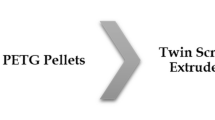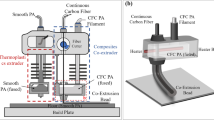Abstract
One flaw associated with fused deposition 3D printing is that the process inherently produces intermittent voids between and inside of deposited layers. Post printing compaction at elevated temperatures of printed parts was previously proposed for reducing the void content within the part and resulted in increased modulus and strength. However, compaction can also lead to embrittlement as the level of crystallinity increases. This work examined the fracture toughness of short and long carbon fiber reinforced polyamide composites using double cantilever beam testing. The critical strain energy release rate behavior was investigated under different compaction temperature levels and for pristine composites. Lower Mode I fracture toughness was found in compacted samples than in unconditioned test samples. The significant variation in Mode I fracture toughness of FDM composites, treated and untreated, was observed and higher values corresponded with the increased intralayer fracture. Both intralayer fractures and interlayer fractures were observed during testing. Interlayer cracks proceeded between two deposited layers of material, while intralayer cracks propagated within a single bead. It was observed that interlayer cracks progressed in a more unstable way than intralayer cracks. Analysis of fracture toughness behavior showed that intralayer failure was more energy-consuming than interlayer fracture due to plasticity of the polymer. Fracture toughness of pristine sample was dominated by nylon plasticity, while increased degree in crystallinity and reduced void content contributed to a more brittle behavior after compaction.

















Similar content being viewed by others
References
Attaran M (2017) The rise of 3D printing: the advantages of additive manufacturing over traditional manufacturing. Bus Horiz 2017(60):677–688
Wu HC, Chen TCT (2017) Quality control issues in 3D-printing manufacturing: a review. Rapid Prototyp J 24(3):607–614. https://doi.org/10.1108/RPJ-02-2017-0031
Ding Q, Li X, Zhang D, Zhao G, Sun Z (2020) Anisotropy of poly(lactic acid)/carbon fiber composites prepared by fused deposition modeling. J Appl Polym Sci 137(23):48786. https://doi.org/10.1002/app.48786
Spoerk M et al (2018) Anisotropic properties of oriented short carbon fibre filled polypropylene parts fabricated by extrusion-based additive manufacturing. Compos A Appl Sci Manuf 113:95–104. https://doi.org/10.1016/j.compositesa.2018.06.018
Dawoud M, Taha I, Ebeid SJ (2016) Mechanical behaviour of ABS: An experimental study using FDM and injection moulding techniques. J Manuf Process 21:39–45. https://doi.org/10.1016/j.jmapro.2015.11.002
Ivey M, Melenka GW, Carey JP, Ayranci C (2017) Characterizing short-fiber-reinforced composites produced using additive manufacturing. Adv Manuf Polym Compos Sci 3(3):81–91
Sauer MJ (2018) Evaluation of the mechanical properties of 3d printed carbon fiber composites. South Dakota State University, 4/262018
Iragi M, Pascual-González C, Esnaola A, Lopes CS, Aretxabaleta L (2019) Ply and interlaminar behaviours of 3D printed continuous carbon fibre-reinforced thermoplastic laminates; effects of processing conditions and microstructure. Addit Manuf 30:100884
Papon EA, Haque A (2018) Tensile properties, void contents, dispersion and fracture behaviour of 3D printed carbon nanofiber reinforced composites. J Reinf Plast Compos 37(6):381–395. https://doi.org/10.1177/0731684417750477
Koch C, Van Hulle L, Rudolph N (2017) Investigation of mechanical anisotropy of the fused filament fabrication process via customized tool path generation. Addit Manuf 16:138–145. https://doi.org/10.1016/j.addma.2017.06.003
Li H, Wang T, Li Q, Yu Z, Wang N (2018) A quantitative investigation of distortion of polylactic acid/PLA) part in FDM from the point of interface residual stress. Int J Adv Manuf Technol 94(1):381–395. https://doi.org/10.1007/s00170-017-0820-1
Casavola C, Cazzato A, Moramarco V, Pappalettera G (2017) Residual stress measurement in fused deposition modelling parts. Polym Testing 58:249–255. https://doi.org/10.1016/j.polymertesting.2017.01.003
Bhandari S, Lopez-Anido RA, Gardner DJ (2019) Enhancing the interlayer tensile strength of 3D printed short carbon fiber reinforced PETG and PLA composites via annealing. Addit Manuf 30:100922
Gao X, Qi S, Kuang X, Su Y, Li J, Wang D (2021) Fused filament fabrication of polymer materials: a review of interlayer bond. Addit Manuf 37:101658
Coogan TJ, Kazmer DO (2019) Modeling of interlayer contact and contact pressure during fused filament fabrication. J Rheol 63(4):655–72
Jain PA, Sattar S, Mulqueen D, Pedrazzoli D, Kravchenko SG, Kravchenko OG (2022) Role of annealing and isostatic compaction on mechanical properties of 3D printed short glass fiber nylon composites. Addit Manuf 51:102599
de Gennes PG (1971) Reptation of a polymer chain in the presence of fixed obstacles. J Chem Phys 55(2):572–579. https://doi.org/10.1063/1.1675789
Kim YH, Wool RP (1983) A theory of healing at a polymer-polymer interface. Macromolecules 16(7):1115–1120. https://doi.org/10.1021/ma00241a013
Coogan TJ, Kazmer DO (2017) Bond and part strength in fused deposition modeling. Rapid Prototyp J 23(2):414–22
Hill N, Haghi M (2014) Deposition direction-dependent failure criteria for fused deposition modeling polycarbonate. Rapid Prototyp J 20(3):221–7
Chacón JM, Caminero MA, García-Plaza E, Núnez PJ (2017) Additive manufacturing of PLA structures using fused deposition modelling: effect of process parameters on mechanical properties and their optimal selection. Mater Design 124:143–57
Huang B, Singamneni S (2015) Raster angle mechanics in fused deposition modelling. J Compos Mater 49(3):363–383
Sun Q, Rizvi GM, Bellehumeur CT, Gu P (2008) Effect of processing conditions on the bonding quality of FDM polymer filaments. Rapid Prototyp J 14(2):72–80
Bellini A, Güçeri S (2003) Mechanical characterization of parts fabricated using fused deposition modeling. Rapid Prototyp J 9(4):252–64
Ramezani Dana H, Barbe F, Delbreilh L, Ben Azzouna M, Guillet A, Breteau T (2019) Polymer additive manufacturing of ABS structure: influence of printing direction on mechanical properties. Elsevier, New York
Gardan J, Makke A, Recho N (2018) Improving the fracture toughness of 3D printed thermoplastic polymers by fused deposition modeling. Int J Fract 210(1–2):1–5
Ko YS, Herrmann D, Tolar O, Elspass WJ, Brändli C (2019) Improving the filament weld-strength of fused filament fabrication products through improved interdiffusion. Addit Manuf 1(29):100815
Dickson AN, Barry JN, McDonnell KA, Dowling DP (2017) Fabrication of continuous carbon, glass and Kevlar fibre reinforced polymer composites using additive manufacturing. Addit Manuf 1(16):146–52
Somireddy M, Singh CV, Czekanski A (2020) Mechanical behaviour of 3D printed composite parts with short carbon fiber reinforcements. Eng Fail Anal 1(107):104232
Justo J, Távara L, García-Guzmán L, París F (2018) Characterization of 3D printed long fibre reinforced composites. Compos Struct 1(185):537–48
Revolinsky P (2021) Post-processing and characterization of additive manufactured carbon fiber reinforced semi-crystalline polymers. Old Dominion University
Uedaa M et al (2020) 3D compaction printing of a continuous carbon fiber reinforced thermoplastic. Compos Part A 137:105985. https://doi.org/10.1016/j.compositesa.2020.105985
Tantillo A (2019) Annealing of fused filament fabricated nylon 6 with elevated isostatic pressure. Theses, vol. Rochester Institute of Technology, no. Department of Industrial and Systems Engineering, Kate Gleason College of Engineering. https://scholarworks.rit.edu/theses/10186
van de Werken N, Koirala P, Ghorbani J, Doyle D, Tehrani M (2020) Investigating the hot isostatic pressing of an additively manufactured continuous carbon fiber reinforced PEEK composite. Addit Manuf. https://doi.org/10.1016/j.addma.2020.101634
Bessell TJ, Hull D, Shortall JB (1975) The effect of polymerization conditions and crystallinity on the mechanical properties and fracture of spherulitic nylon 6. J Mater Sci 10(7):1127–1136
ASTM (2009) ASTM D 5528-01 standard test method for mode I interlaminar fracture toughness of unidirectional fiber-reinforced polymer matrix composites
Onyx (2021) Markforged. https://markforged.com/materials/plastics/onyx. Accessed 11 Oct, 2021
Kabir SF, Mathur K, Seyam AF (2020) The road to improved fiber-reinforced 3D printing technology. MDPI Technol 8(4):51
Kravchenko OG, Kravchenko SG, Casares A, Pipes RB (2015) Digital image correlation measurement of resin chemical and thermal shrinkage after gelation. J Mater Sci 50:5244–5252
Vicard C, De Almeida O, Cantarel A, Bernhart G (2017) Experimental study of polymerization and crystallization kinetics of polyamide 6 obtained by anionic ring opening polymerization of ε-caprolactam. Polymer 132:88–97. https://doi.org/10.1016/j.polymer.2017.10.039
Siengchin S, Karger-Kocsis J (2011) Structure, mechanical, and fracture properties of nanoreinforced and HNBR-toughened polyamide-6. J Appl Polym Sci 123:897–902
Xiao H, Zhao X (2004) Effects of annealing (solid and melt) on the time evolution of polymorphic structure of PA6/silicate nanocomposites. Polymer 45:3819–25
Author information
Authors and Affiliations
Corresponding author
Additional information
Publisher's Note
Springer Nature remains neutral with regard to jurisdictional claims in published maps and institutional affiliations.
Appendix A
Rights and permissions
Springer Nature or its licensor (e.g. a society or other partner) holds exclusive rights to this article under a publishing agreement with the author(s) or other rightsholder(s); author self-archiving of the accepted manuscript version of this article is solely governed by the terms of such publishing agreement and applicable law.
About this article
Cite this article
Barber, J., Revolinsky, P., Spinelli, E. et al. Investigation of high temperature compaction on fracture toughness of 3D printed carbon fiber polyamide composites. Prog Addit Manuf (2023). https://doi.org/10.1007/s40964-023-00507-7
Received:
Accepted:
Published:
DOI: https://doi.org/10.1007/s40964-023-00507-7




